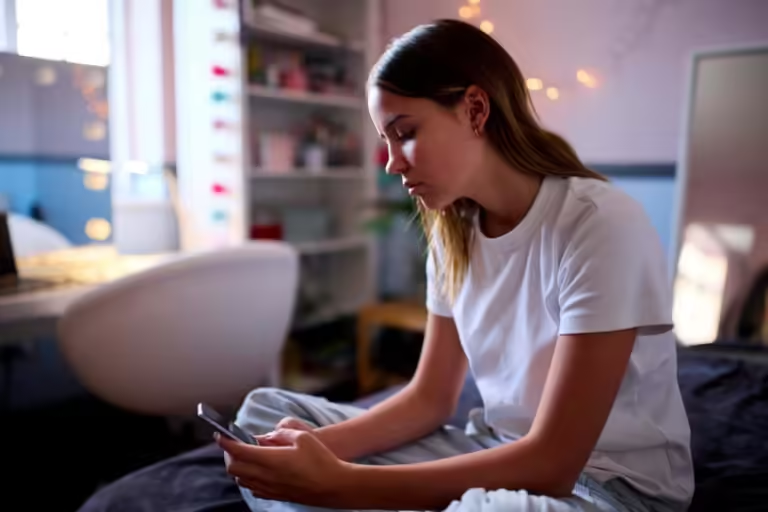
Some young people are on their cell phones until late at night.
Monkey Business Images/Shutterstock
Two recent studies have linked “problematic smartphone use” among teenagers to increased symptoms of anxiety, depression and insomnia. But is this really a problem, and how much, if anything, should we be worried about?
What is ‘problematic smartphone use’?
The researchers in both studies defined smartphone use as “problematic” when people lose a sense of control over their use, become obsessed with their phone at the expense of meaningful activities, and feel stressed when they can’t use it. Use becomes problematic when it interferes with work, school or relationships, says John Elhai of the University of Toledo in Ohio, who was not involved in either study.
“Problematic smartphone use” is not recognized as a diagnosable condition by public health agencies such as the World Health Organization, the US Centers for Disease Control and Prevention, or the UK’s National Health Service.
Both studies found links to specific conditions, which means more research is needed to see whether smartphone use could cause such health problems, said Nicola Kalk of King’s College London, who was involved in both studies.
What did the two studies find?
In one study, Kalk and his colleagues surveyed the smartphone use of more than 650 young people between the ages of 16 and 18. They used a “smartphone addiction scale,” which asks, for example, whether smartphone use blurs your vision or makes you feel irritable when you’re not holding your phone. The scale produces a score between 10 and 60, with anything above 30 considered problematic.
Nineteen percent of participants met the definition of problematic smartphone use, and these people were twice as likely to report moderate anxiety symptoms and almost three times as likely to report moderate depressive symptoms compared to their peers.
On average, problematic smartphone users spent 29 more minutes per day on Instagram and 22 more minutes on TikTok than non-problematic smartphone users. There was no association between problematic smartphone use and other apps such as Snapchat or WhatsApp.
The team took into account factors that could have influenced the results, such as the amount of time participants spent on their smartphones each day. “We also analyzed the effects of (general) screen time separately from the effects of problematic smartphone use, and found that screen time was not associated with anxiety or depression, whereas problematic smartphone use was,” Kalk said.
In a second study, a different team looked at smartphone use and symptoms of anxiety, depression, and insomnia in 69 young people aged 13 to 16. The researchers found that 44% of participants met the definition of problematic smartphone use, based on the same addiction scale.
The research team resurveyed the 62 participants one month later and found that increased severity of problematic smartphone use over that period was associated with greater symptoms of anxiety, depression and insomnia.
Should you be worried about “problematic smartphone use”?
These studies are small and don’t prove that problematic smartphone use actually causes declines in teen mental health, says Sunny Xun Liu of Stanford University.
Kalk and Ben Carter of King’s College London, who worked on both studies, acknowledge that young people who are already experiencing these symptoms may be using their phones in more problematic ways than those without mental illness. “There may be a two-way connection, but we don’t yet know if there’s a causal relationship,” says Jay Olson of the University of Toronto in Canada.
For example, people with depression may be more likely to rely on their mobile phones than those without depression because they find comfort in communicating with loved ones, and people with insomnia may be more likely to turn to their mobile phones to stave off boredom in the middle of the night.
In the second study, participants who showed signs of problematic smartphone use were five times more likely to say they wanted to cut down on their device use than those without such use. The fact that these teens want to cut down on their phone use makes the results “both worrying and positive,” Carter said.
If you are worried, how can you cut down on your smartphone usage?
The first study found that 95% of people surveyed tried to limit their smartphone use: They said the most effective strategies were to occasionally put their devices on “do not disturb” mode, turn off notifications, and keep them in another room at bedtime.
Kalk said that rather than restricting teens’ cell phone use, parents and schools should talk to them about what aspects of smartphone use are beneficial and what aspects are harmful. For example, some teens reported that they enjoyed using their smartphones to stay in touch with loved ones, but also reported that smartphones were sometimes distracting.
topic:
- mental health/
- smartphone

